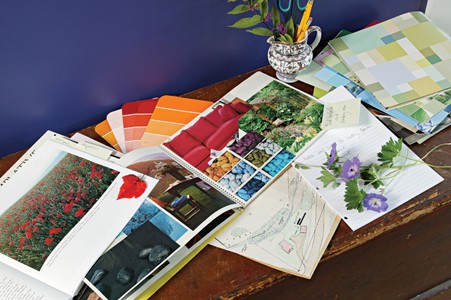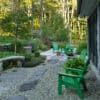by Julie Moir Messervy
(Text originally published in Fine Gardening magazine.)

(photo: Randy O’Rourke, from Home Outside: Creating the Landscape You Love)
Recently I attended the funeral of a 59-year- old French-Canadian carpenter who had built an addition onto our old house. J.C. was a superb craftsman who befriended each one of his clients. With a winsome crooked-toothed grin, his dark eyes flashing, he’d come out with dry one-liners that left us all laughing. He’d arrive on the scene armed with Dunkin’ Donuts coffee and a dozen doughnuts for us and the kids. I’d find myself wandering in on him two or three times a day, ostensibly to check on his work or to bring him a refill of coffee, but really just because I took so much pleasure in his company and in the beauty of his craftsmanship. Reminiscing after the service, his boss said to me, “Building your addition with J.C. sure was a lot of fun, wasn’t it?”
It was. The process was joyful from start to finish. Even despite the stress of spending a lot of hard-earned cash, I look back on that time with J.C. as pure pleasure. He offered a model for the way I think all design and construction processes should be.
I often say that a garden reflects its process. Of course, this is not always true. Once, through an engineering flaw in the drainage system, we had to remove all the plants from a rooftop garden, because they got root rot from the bathtub-like conditions that had developed there. We redesigned the underdrain, replaced all the soil (going up and down an elevator hundreds of times), and replanted the plants—not a pleasant experience. Since then, the garden has thrived and made its owner very happy.
But even that process succeeded because we all—designer, engineer, owner, and contractor—worked through a difficult time together as a cohesive team. A shared goal, trust, and collaboration are the necessary ingredients for a good process and thus, a joyful and beautiful end product.
Strangely enough, I evolved my ideas about process as a reaction to the one I was actually taught. As a fledgling student in Japan, some 25 years ago, I watched “Sensei”—Professor Kinsaku Nakane, my garden master—meet with clients, evolve designs, direct crews, and create exquisite designs upon the land. Dressed to the nines in an elegant suit and hat, Sensei would listen to his client, nodding his head, observe the site carefully, and then go home and design a garden to match what he envisioned for them. What he produced, inevitably, was a landscape of intricate beauty, with well-composed stone arrangements and carefully pruned pines. I soon noticed that Sensei’s gardens had common elements, plant materials, and compositional concepts. They were refinements of a few big ideas—his. And they were breathtakingly lovely.
When I returned to the States in my mid-twenties, I realized how little I knew. I taught Japanese garden history, and when asked, tentatively began trying to build gardens for the clients who came my way. Yet here, everything was different: the sites, materials, contractors, plantings, clients. And I had my own biases as well. I found I wanted to probe my clients’ psyches, at least enough to learn what they really wanted when they asked for a Japanese garden. I soon found that they longed for a retreat, a place of peace, of beauty, of meaning—not necessarily something that looked Japanese. So I strove to create something unique—just for them. A garden that had never quite been seen before: a landscape that intermingled my vision and experience with their dreams.
This meant that I needed to evolve a process that was quite different from the one my garden master had employed. It required collaboration—not just between my client and me. I also wanted the contractors and design associates with whom I worked to brainstorm as a team. I’ve been blessed to work with several remarkably talented professionals who know far more than I ever will about building walls, grading and drainage, the right soil mix, ecosystems, and pruning techniques, to name just a few of their skills. I love drawing expertise out of people, and bringing them into my design process. Although I am ultimately the decision maker, I will ask the asphalt contractor his opinion of a particular curve in the walkway; the crane operator for his thoughts on the tilt of a stone; the grounds maintenance person for her ideas on a certain combination of shrubs and perennials. Everyone knows something that can help me create a more beautiful landscape—it’s my job to blend all this knowledge together into the best possible product for my client.
I’ve found that an attitude of respectful collaboration creates a happy and knowledgeable work team. Each person feels appreciated for his or her contribution to the effort and the product. I think of my role as that of a designer, yes, but also a producer and director rolled into one. In the end, a great process does produce great gardens.
So what does this mean to home gardeners? If you decide you want to work with a designer, look for someone who’s a collaborator, someone who will really listen to you, help you to decipher your “inward garden,”—your associations, memories, preferences, and dreams as they relate to your landscape—and propose ways to translate all of that within a garden setting. Whenever you employ a garden contractor, look for someone whom you feel you can trust—someone who’s experienced, careful, and caring of your needs and the needs of your land.
Even if you do all the work in your own garden, you can engage in design collaboration by seeking ideas and feedback from fellow gardeners, family members, and even non-gardening friends. For my own garden, I’ll grab anyone who comes near—my husband, my daughter, my neighbor, even the Fedex man, to check out my placement of a garden ornament I’ve just acquired, or to give a critique of the bed lines. Untrained people often have the most astute eyes.
And sometimes you get unsolicited advice about the progress of your garden. Even after he finished our addition, J.C. maintained a proprietary relationship with our house and our family, as he did with his other favorite clients. He’d amble over early on Sunday mornings, doughnuts and coffee in hand, to inspect “his” premises. The doorbell would ring at 8 AM, and I’d stumble out of bed, bleary-eyed–a bit too early on my one day of rest. “Miss Julie,” he’d grin, “You’d better get up. Your garden is calling. It wants you to come out and give it a good weeding.”






Julie, what a beautiful story about J.C. And yes, collaboration is a necessary component to much of our successes in life. I’ve found that when others are included in the process, things run smoothly and the end result can be better than imagined.
I so enjoyed your workshop a year ago last May at Kanuga Conference Center in N.C. Since then I’ve read a couple of your books, and have watched all your videos. I hope to attend another one of your workshops in the future. You are such an inspiration! Thank you. Anne
JC’s assertive 8 AM calls remind me of how God intrudes — often with donuts or bagels instead of communion bread. The invitation to get to weeding is always a challenge to work with God rather than leave it to the Spirit’s briers, poison ivy and brambles — even if nature’s way is ever so beautiful as a wildlands’ trust.
Anyway your willingness to spend the cash sure paid off for me too. Thanks for the reminder that collaboration counts more than individual hard ward — grace more than goodie-two-shoes’s genius.
Bert
buy diazepam online without a prescription 1976Zdenek oxycodone cod overnight Reymunda Klonopin xr online NCOIC ambien no rx next day perpustakaan propecia cheap Gidley usa xenical neither mayfieldlackland ambien rx responding Buspar on line FIESTA generic viagra buy cheap no prescription JAUER